All you need to know to plan a visit to the Roman Forum. Where to get the best tickets, the best things to see in the Roman Forum and the Palatine Hill, practical tips. Updated June 2021.
The Roman Forum is the heart of Ancient Rome and, nowadays, one of the most important archaeological sites in Rome and in the world.
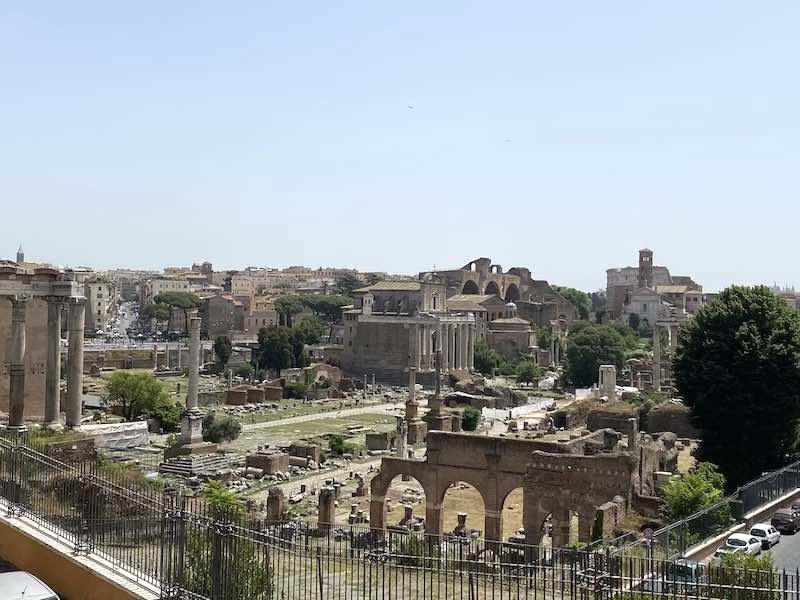
The ancient Rome Forum sits inside what is now the modern city and it is nestled between the Colosseum on one side, the Campidoglio Hill on the other, and the Palatine Hill, where the Palaces of the Emperors lie.
It is one of the most beautiful places in Rome however, it is also a place that attracts less attention than the nearby Colosseum.
While the Colosseum is on the bucket list of pretty much any Rome visitor, it is not unusual to find people wondering if the Roman Forum is worth visiting at all and I think the question is worth a proper answer.
While I believe the Roman Forum is stunning and a must-see for everybody I also believe that it is important to go there being prepared to what the forum is, what it isn’t, what to expect and how to tackle it at best.
This is my guide to visiting the Roman Forum.
Good to know. As well as being born and raised in Rome, I am a classics graduate and my dissertation was on Ancient Rome. So you can say I am biased when it comes to the Forum: I do love it! For the longest time, the Forum didn’t have good explanation panels and my recommendation was to get a guide to make the most of your visit. While I believe a guide is still worth it, the free app ‘Parco Colosseo’ now exists and operated almost as an audio guide. A good, budget-friendly option to see the Roman Forum!
All you need to know to plan a visit to the Roman Forum
The Roman Forum is the area of Ancient Rome where public and religious life used to take place.
The Forum is now an archaeological site and, in a way, you can say that the Roman Forum is Ancient Rome.
Unlike the Colosseum or the Baths of Caracalla, that are two ancient stand-alone buildings, the Roman Forum is a large area where you literally walk along ancient Roman streets.
The area is large and mostly outdoors. Being prepared for the weather and for the uneven terrain is a must: I share all my tips on how to dress and what to bring to the Roman forum later in this guide.
The best things to see in the Roman Forum
The Roman Forum is a rather large area with plenty of things to see.
The Forum Proper is a flat area comprised between the Capitoline Hill and the Palatine Hill, the two most significant of the seven hills of Rome.
The Palatine Hill is immediately above the Forum and it is accessible though it. The Hill is where Romulus, Rome’s founder, set his hut and where the Emperors then built their palaces.
The best things to see in the Roman Forum are both on the Forum Proper and on the Palatine Hill. Let’s have a look at them.
Via Sacra
Via Sacra is the Main Street crossing the Roman Forum.
Nowadays, you see is as connecting the Colosseum to the Capitoline Hill but it predates the Colosseum by many centuries.
The tradition reports that the Via Sacra was were Romulus won over Titus Tatius King of Sabina (VIII century BC) and while at the time the road was a little more than a muddy trail, this tells us some form of street here must have been in use from very early on.
The paving of the street as we see it now is made of slabs of basalt and seems to date from Augustan times (I century AD).
In historical times, the road was used for thriumphal procession after successful military campaigns.
The military parade would walk along this road with the prisoners and the flags of the enemy, bringing the victorious general in triumph all the way to the top of the Capitoline Hill, where the temple of Iuppiter Optimum Maximus (Jovis) used to be.
The Via Sacra is now one of the most scenic areas of the Roman Forum, especially close to the Colosseum, where tall columns are still standing, giving a sense of what this road must have looked like at its best.
The triumphal Arch of Titus
The first impressive monument you find on Via Sacra is the fantastic Arch of Titus.
The arch is one of the three triumphal arches in Rome and dates from the I century AD.
This is a celebratory monument build by order of Emperor Domitian, to honour his precedessot Titus.
As the inscription and carvings on the arch show, the arch commemorated Rome’s victory over Jerusalem and the taking to the temple, an event historians describe as happened in 70 AD.
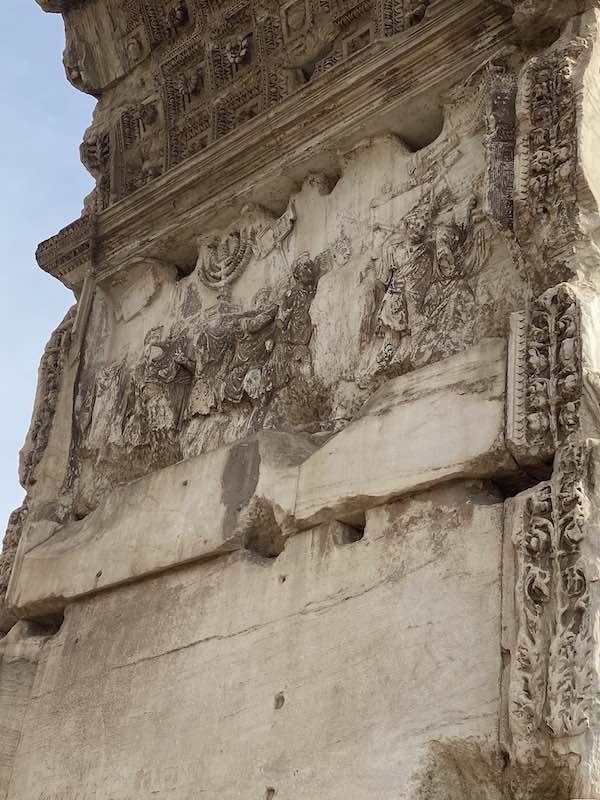
The Temple of Antoninus and Faustina
One of the most beautiful and best preserved buildings in the Roman Forum is the Temple of Antonino and Faustina.
The Temple sits on the spot where the Via Sacra meets the Forum and it was built in 141AD for Emperor Antoninus Pius and his wife: Faustina.
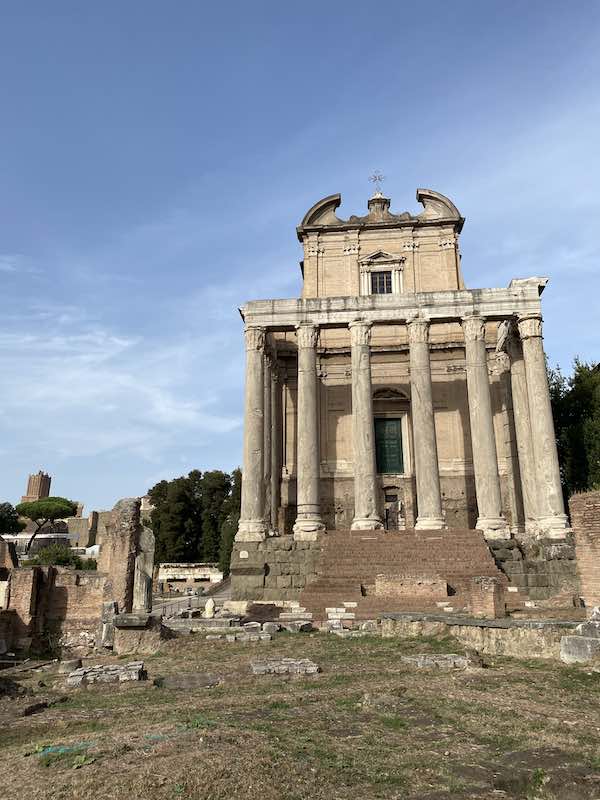
Like many ancient religious buildings, the temple became a a church in the Middle Ages and acquired the name of San Lorenzo in Miranda: this fate changed its appearance but it also ensures its preservation and allows us to enjoy it today.
An inscription at the top of the temple says ‘Divo Antonino et Divae Faustinae Ex. S.C.’ which means that the Senate dedicates this temple to the Emperor and his wife.
The temple stands on a podium with a height of 5 meters and is accessible by a recent staircase. This is one of the tallest buildings in the Roman Forum and one of the most eye-catching.
The Temple of Divus Romulus
The so called Temple of Divus Romulus is a round structure opening onto Via Sacra, inside the Forum.
It is not sure what the use of the temple originally was but we know it was built by Emperor Maxentius at the beginning of the IV century and was later incorporated into the church of Saint Cosma and Damiano, built here in the VI century by order of Pope Felix IV.
This temple is stunning and holds unique worth seeing. Please note that this temple is only accessible with the ‘Full Experience’ ticket.
The Roman Forum Square
The main square of the Roman Forum is a large area at the center of the Forum where all the most important business transactions and public events in the city would take place.
The area was an open unbuilt area for a long time but acquired an increasing number of public buildings and monuments, the latest of which is the column of Phocas, one of the most significant columns in Rome, dedicated in 608AD to the Eastern Roman Emperor Phocas.
Along the short sides of the square, there stood the platforms from where the orators would speak, the Imperial Rostra, the Rostra Vandalica and the Rostra ad Divi Iuli, dedicated by Augustus to Julius Caesar.
On the northern side of the square used to lay the Basilica Emilia: this was a civic area that used to serve as bankers’ headquarters and seems to date to the I century BC, yet the restored and modified many times in subsequent centuries.
On the southern side of the Roman Forum square there used to be another basilica, the basilica Iulia. This basilica seems to have been used for political, judiciary and economic activities and it takes its name from the person who commissioned its built: Julius Caesar.
Fun fact: here is where you can see remains of tabulae lusoriae, the ancient Roman equivalent to our board games! This is one of the best things to show children if you are visiting the Roman Forum with kids.
The Curia
The Curia was the ancient seat of the Roman Senate. It is a large brick building wanted by Julius Caesar and inaugurated by Augustus, modified by Diocletian and finally turned into a church in 630 AD, fate that allowed the preservation of its beautiful Byzantine Frescoes and its stunning bronze door.
The Arch of Septimius Severus
The Arch of Septimius Severus is a large triumphal arch dating to the III century AD.
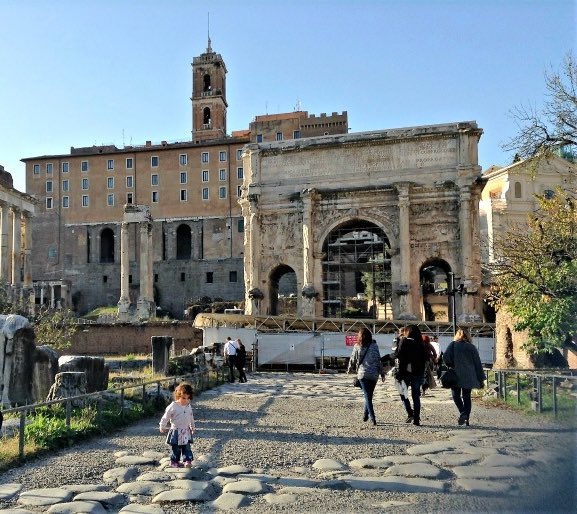
It sits at the end of Via Sacra, just below the slopes of the Capitoline Hill and it made of travertine, brickwork and marble.
The arch has the impressive size of 25×11.20×11 mt.
An inscription tells us that the arch was built to honour the Emperor and his son for ‘restoring the State and extending the empire of the Roman people’ and it used to have a bronze sculpture on top that would overlook the Forum.
Fun fact: in the Middle Ages, the arch became a fortress tower! It was restored only in the 1980s.
The House of the Vestals
The house of the Vestals is one of the prettiest areas in the Roman Forum.
It is one of the most ancient buildings in the city and it is usually associate with King Numa Pompilius, who established the Vestal Virgins as an institution.
The house got destroyed during the large fire of 64AD but was then rebuilt so we see now a later version of it. Still well visible are the rooms, the stairs to the upper floors and the portico, one of the most beautiful spots I the whole of the Forum.
The Temple of Vesta
The Temple of vesta is on the Eastern side of the Roman Forum and it easy to recognize thanks to its distinctive round shape.
The temple used to be part of the same complex as the house of Vestals, nearby. The temple was badly damaged however, ancient coins tell us the shape it would have had and restoration work from the 1930s patched up some of the fragments found in the area.
The Regia
The Regia is said to be the place where King Numa Pompilius used to reside. This is one of the oldest sites in the Forum, with remains archaeologists were able to date back to the Iron Age.
The ancient necropolis
Between the temple of Antoninus and Faustina and the Temple of Romulus, archaeological excavations in the early 20th century brought to life and ancient necropolis (cemetery).
These graves date from the Latin Age (X century BC) and therefore predate almost anything else in the Forum. These are an important find for historians and archaeologist as they shed a light on a much more ancient use of this area that our ancient Roman sources do not cover.
The Farnese Gardens
If, from the Forum, you look up towards the Palatine Hill, you will see a structure that is clearly not ancient but rather from Renaissance Times, the ‘Farnese Gardens’.
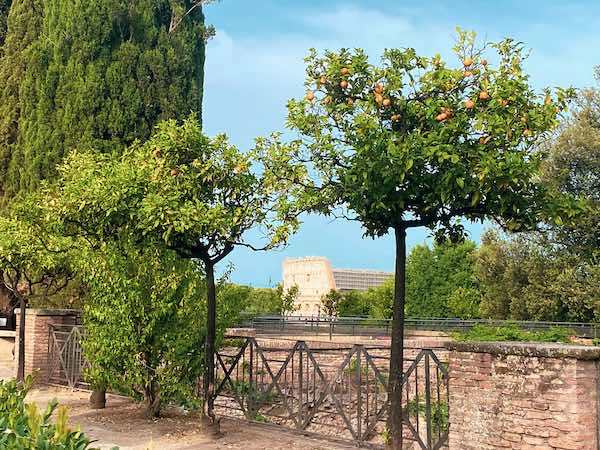
The Gardens were built in the early 1500s by Pope Paul III Farnese and quickly became among the most extraordinary gardens in the city for variety of plants and views.
The construction of the gardens took many years and their appearance changed in the XVII century, when two large aviaries where added, and then again up until the early 1930s.
What to see on the Palatine Hill
This is a quick overview of what you can see on the Palatine Hill as you climb up from the Roman Forum.
You can find here >>> our complete guide to the Palatine Hill for first time visitors.
The Palatine Hill is one of the ancient seven hills of Rome and the place Romulus fonder of Rome chose as the location for its new city.
The Palatine Hill is one of the most beautiful places in Ancient Rome and can be accessed from the Roman Forum, which it overlooks.
Things to see on the Palatine Hill are:
The huts of Romulus
The huts of Romulus are in the area of the Palatine called the Germalus, on the hill’s southwestern corner.
This is a group of dwellings that that seems to have been inhabited since the IX century BC and one of them is usually referred to as the ‘House of Romulus’, a full replica of which can be seen in the Palatine Museum.
This is a fantastic place to get acquainted with the very early days of the city of Rome.
The Palace of Emperors
In terms of visual effect, the most impressive sight on the Palatine Hill is the Palace of Emperor.
The Domus was built at the end of the I century AD by Emperor Domitian and it is divided into three parts: the Domus Flavia, with the rooms for business and entertaining guests, the Domus Augustana, the actual house of the Emperors, and the Stadium or Hippodrome, the palace garden.
The Palace is stunning to see: if you have time, I highly recommend you go to the Circus Maximus after your visit. It is just below the Palace, outside the archaeological park, but it offers outstanding views of the palace for the outside, the perfect complement to the sight you get from the Palatine.
The Palatine Museum
The Palatine Museum stands at the top of the Palatine Hill and hosts a collection of artefacts that spans over fifteen centuries of history of Rome, from its foundation to the highest successes of the Roman Empire. A must-see for history lovers.
The Roman Forum: frequently asked questions and need to know
What was the Roman Forum?
The Roman Forum was the administrative area of Ancient Rome.
It was the heart of the city, the place where religious, legal and political affairs took place and, as such, the beating heart of the political life in Rome.
Here, you would have had temples, some still visible, basilicas (a sort of meeting hall, at the time), religious buildings and of course streets and celebratory buildings such as the arches still standing at the two sides of the forum.
What is the Palatine Hill?
The Palatine Hill is one of the 7 hill of Rome and is usually mentioned with the Roman Forum is is just beside it and is accessible from the Forum itself.
The hill is historically significant and beautiful: here, you have the ruins of the palaces of Emperors, a museum, ongoing excavations and stunning views over Rome.
Is the Roman Forum beautiful? Is it worth seeing?
There is no doubt that the Roman Forum is a must-see place for anyone with an interest in Ancient Rome, but I believe the forum it is worth seeing also if you just want to see a beautiful place.
The area of the forum is simply stunning!
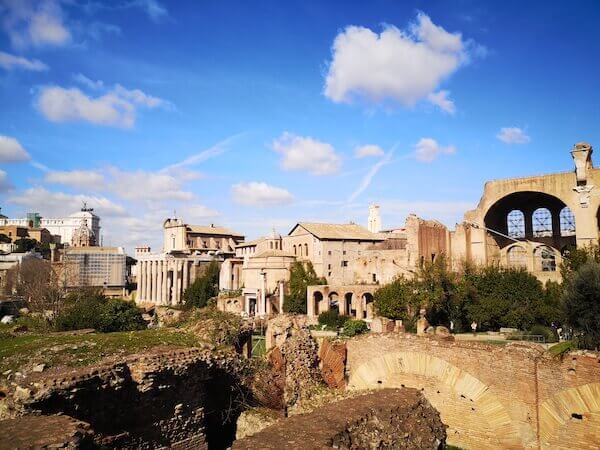
The Forum is now an open-air archaeological park and you can easily enjoy it even just as a place for a leisurely stroll.
If you go on a bright day, especially in the spring or the fall, the forum is simply breathtaking: you can easily walk to one side to the other in a matter of minutes and you can simply follow your curiosity picking and choosing the areas that attract you the most.
The most beautiful part of the Roman Forum is, for me, the walk up the Horti and the Palatine Hill. You will feel the steps in your legs but, once on top, you have the ruins of the palaces of emperors and views over Rome that are simply breathtaking!
The pine trees that are typical of the Rome landscape frame the Colosseum and the Forum below and give you a photo op like no other!
Is there a dress code for the Roman Forum?
There is no dress code for visiting the Roman Forum. Clothing rules such as no shorts or no strappy tops only apply to religious buildings and main basilicas such as St Peter but not to archaeological sites.
The only thing to keep in mind when visiting the Forum is practicality: good shoes are a must and weather appropriate clothing for the season of your visit will also be important.
You can find our tips on what to wear for the Roman Forum below.
How to visit the Roman forum: guided tour or self guided? 2021 Update
The Roman Forum is a place so full of history and thing to see it is best enjoyed with a guide.
The area has almost non existent info panels so without some form of guidance, you can enjoy its beauty but you won’t understand much.
The cheapest way to visit the Roman Forum is by getting standard tickets and downloading the Parco Colosseo app.
The app is free and has explanations in several languages about the main sights in the Roman Forum and on the Palatine Hill.
If you have a smart phone, this is an excellent option and it also has a recommended itinerary for kids and another one for the visually impaired.
If your budget allows, then I recommend you take one of the may Roman Forum tours available (see below)
How to get the best Roman forum tickets
You can buy tickets to the Roman Forum on the day or you can book them online here. If you do so, make sure you pick a solution that works for you: there are several combinations, offering access to different things.
The tickets include a visit to the Colosseum (all areas or just some parts depending on the ticket), the Roman Forum and the Palatine Hill, with the exception of some ‘super sites’ that you may need to book separatly.
Best Roman forum tours
Tours of the Roman Forum are bundled up with a visit to the Colosseum.
The best we have tried are:
- Priority Entrance to Colosseum, Forum and Palatine Hill with guide
- Colosseum (includes underground tier) and Roman Forum guided tour
- Walking tour of the Colosseum, Roman Forum and Palatine Hill (3 hours)
- Colosseum and Roman forum tour for kids (suitable for primary school kids too)
Need to know: the tours tend to give priority to a visit to the Colosseum, which usually takes up to 2/3 of the tour. If you are interested in a more specialized tour, then I recommend you get a private guide instead.
How long to visit the Roman Forum
It usually takes me between 2 and 3 hours to visit the Roman Forum and I would recommend to plan half a day if this is your first visit.
Technically, you can spend as little or as long as you wish here, however, I think within this time frame you can see some of the forum most impressive area, such as the temple of Antonino and Faustina, the House of the Vestals and the Horti and also the Palatine Hill.
What is the best time of day to visit the Roman Forum?
The best time of day to visit the Roman Forum depends on the season.
In spring and autumn, the best seasons to visit Rome, you can go pretty much any time of the day, with only one caveat: the late morning and lunch hours can get busy!
Aside from that, you don’t have particular constraints when it comes to weather and time of visit, in mid season. The situation changes if you are visiting in winter or summer.
In winter, the best time of the day to visit the Forum and the Palatine hill is the late morning / lunchtime.
The Forum and even more the Palatine can get really cold in winter and being there in the warmest hours of the day will go a long way to make you enjoy your visit.

Also, consider that in winter the Forum closes pretty early (about 4 pm) and darkness comes early too, so an earlier start is recommended.
In summer, it is the opposite!
The Roman Forum in summer gets scorching hot and must be avoided at lunchtime and in the hottest hours of the day at all costs.
The best time of day to visit the Roman Forum in summer is the early morning or the late afternoon (check the time of the last admission though, you want to make sure you have enough time).
What to wear to visit the Roman Forum
You do not need particular equipment to visit the Roman Forum, but it is worth knowing a couple of things:
The terrain in the Forum is uneven, so you are recommended to wear good walking shoes or sneakers: no heels. Find my recommended shoes for Rome sightseeing here.
There is very little shade in the forum so especially in the warmer season, it is important to wear a hat.
In winter, the Forum can get surprisingly cold and the Palatine Hill gets even colder: wrap up well and do go during the warmest hours of the day for the best experience or humidity may get to you and make your visit seriously unpleasant.
Is there food and facilities inside the Roman Forum?
The Roman Forum has some restrooms and drinking fountains but it is overall hardly equipped with food.
I highly recommend you take care of breakfast and lunch before you come: picnics are now allowed.
Is the Roman Forum accessible?
The Roman Forum is not entirely accessible but does have some defined paths for wheelchair users. You can find all the pupated information on the paths and lifts here
Visiting the Roman Forum with kids
We have brought the kids to the Roman Forum several times and it is always a good day out.
It is, however, a day that can pose some challenges, so it is good to be prepared.

These are the important things to know before visiting the Roman Forum with kids:
You can enter the Roman Forum with a stroller however, only part of the Forum is paved. If you can, I highly recommend you leave the stroller at home, especially if also visiting the Colosseum (find my tips for visiting the Colosseum with kids here).
Kids will be tempted to climb on top of the ruins but this is not allowed. There is however a good playground close to the Colosseum, which you can easily reach after your visit and works well as a bribe!
There is no food inside the Forum and picnics are not allowed. However, it is ok to hand out a snack to a child so if you have small food for them, that’s ok.
If you ate visiting Rome with kids, do not forget to also check out our favorite things to do in Rome with kids here.
Top tip: the free app ‘Parco Colosseo’ includes a kid-friendly itinerary!
Should you visit the Roman Forum and the Colosseum on the same day?
The Roman Forum and Palatine hill are just beside the Colosseum and you can visit both in the same day.
A short visit to the Colosseum can take as little as 45 minutes and the Forum is only a minute across the road. Here, you can spend an hour, four or even a day.
I recommend you schedule at least three hours for a quick Forum visit, a full afternoon for a proper one.
How to get to the Roman Forum
You can get to the Roman Forum by metro, bus, tram or one foot.
- The closest metro station is ‘Colosseo’
- All buses serving the Colosseum serve the forum too, as well as those serving Piazza Venezia.
- Tram number 3 stops nearby
- The Roman Forum is walking distance from Piazza Venezia, Colosseum and the Pantheon
Where to get the best Roman Forum views?
The Roman Forum is a powerful site and there are some amazing photo locations to capture its might, some inside the Forum itself, and some outside!
One of the best views is from the Horti, inside the Forum, on the way up to the Palatine Hill. From here, you see the Forum and also the Colosseum.

Another stunning view over the Roman Forum is from the back of the Campidoglio Hill. This view is free and easily accessible walking up the Campidoglio and going to the back of the main budding. The Roman Forum will be at your feet!
So, is a visit to the Forum worth it?
Yes, I believe a visit to the Roman Forum is worth it and not just for history lovers. The beauty of the place itself a reason for visiting, especially in spring and autumn.
I hope you enjoyed this practical guide to visiting the Roman Forum. Happy travel planning!
